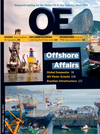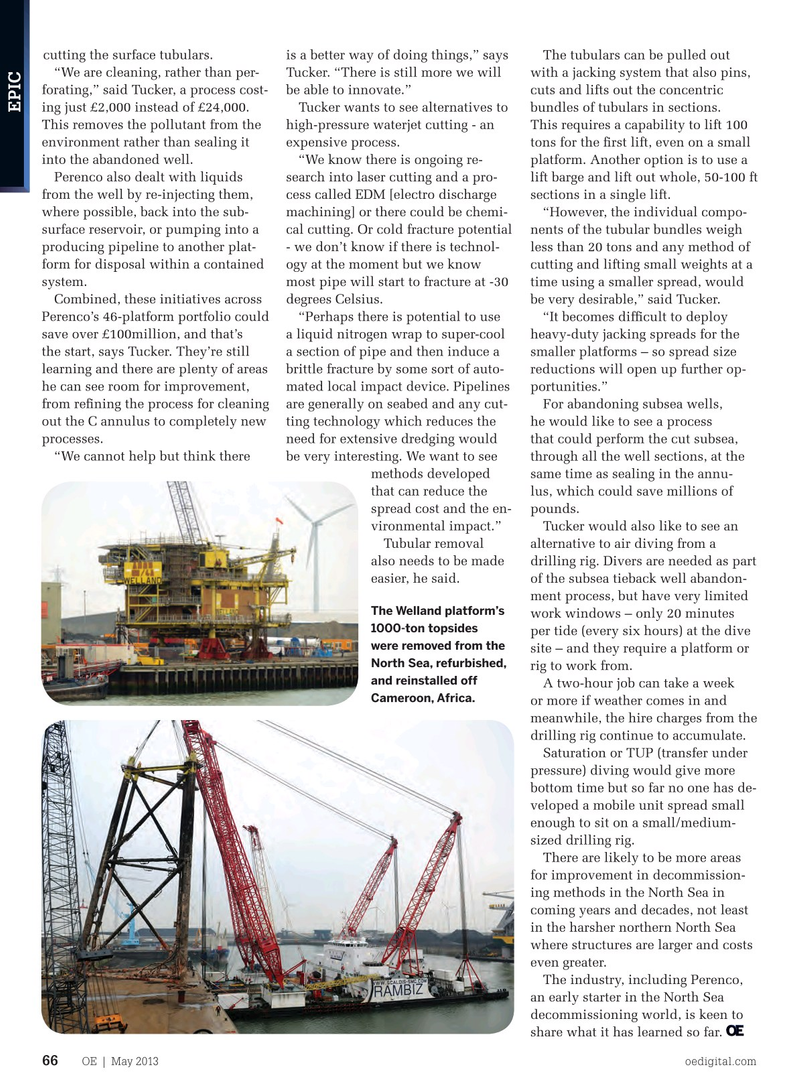
Page 64: of Offshore Engineer Magazine (May/Jun 2013)
Read this page in Pdf, Flash or Html5 edition of May/Jun 2013 Offshore Engineer Magazine
cutting the surface tubulars. is a better way of doing things,” says The tubulars can be pulled out “We are cleaning, rather than per- Tucker. “There is still more we will with a jacking system that also pins, forating,” said Tucker, a process cost- be able to innovate.” cuts and lifts out the concentric ing just £2,000 instead of £24,000. Tucker wants to see alternatives to bundles of tubulars in sections.
EPIC
This removes the pollutant from the high-pressure waterjet cutting - an This requires a capability to lift 100 environment rather than sealing it expensive process. tons for the frst lift, even on a small into the abandoned well. “We know there is ongoing re- platform. Another option is to use a
Perenco also dealt with liquids search into laser cutting and a pro- lift barge and lift out whole, 50-100 ft from the well by re-injecting them, cess called EDM [electro discharge sections in a single lift.
where possible, back into the sub- machining] or there could be chemi- “However, the individual compo- surface reservoir, or pumping into a cal cutting. Or cold fracture potential nents of the tubular bundles weigh producing pipeline to another plat- - we don’t know if there is technol- less than 20 tons and any method of form for disposal within a contained ogy at the moment but we know cutting and lifting small weights at a system. most pipe will start to fracture at -30 time using a smaller spread, would
Combined, these initiatives across degrees Celsius. be very desirable,” said Tucker.
Perenco’s 46-platform portfolio could “Perhaps there is potential to use “It becomes diffcult to deploy save over £100million, and that’s a liquid nitrogen wrap to super-cool heavy-duty jacking spreads for the the start, says Tucker. They’re still a section of pipe and then induce a smaller platforms – so spread size learning and there are plenty of areas brittle fracture by some sort of auto- reductions will open up further op- he can see room for improvement, mated local impact device. Pipelines portunities.” from refning the process for cleaning are generally on seabed and any cut- For abandoning subsea wells, out the C annulus to completely new ting technology which reduces the he would like to see a process processes. need for extensive dredging would that could perform the cut subsea, “We cannot help but think there be very interesting. We want to see through all the well sections, at the methods developed same time as sealing in the annu- that can reduce the lus, which could save millions of spread cost and the en- pounds.
vironmental impact.” Tucker would also like to see an
Tubular removal alternative to air diving from a also needs to be made drilling rig. Divers are needed as part easier, he said. of the subsea tieback well abandon- ment process, but have very limited
The Welland platform’s work windows – only 20 minutes 1000-ton topsides per tide (every six hours) at the dive were removed from the site – and they require a platform or
North Sea, refurbished, rig to work from. and reinstalled off
A two-hour job can take a week
Cameroon, Africa.
or more if weather comes in and meanwhile, the hire charges from the drilling rig continue to accumulate.
Saturation or TUP (transfer under pressure) diving would give more bottom time but so far no one has de- veloped a mobile unit spread small enough to sit on a small/medium- sized drilling rig.
There are likely to be more areas for improvement in decommission- ing methods in the North Sea in coming years and decades, not least in the harsher northern North Sea where structures are larger and costs even greater.
The industry, including Perenco, an early starter in the North Sea decommissioning world, is keen to share what it has learned so far.
OE | May 2013 oedigital.com 66
EPIC3_PerencoDecomm-Elaine.indd 65 4/22/13 4:56 PM

 63
63

 65
65